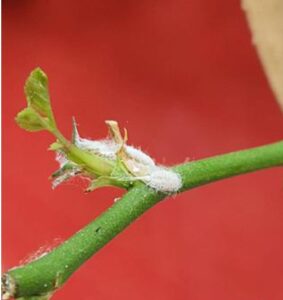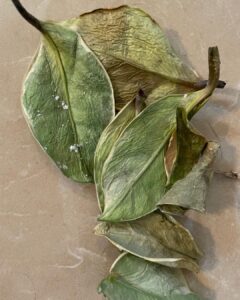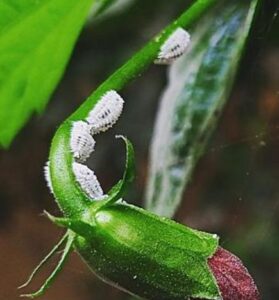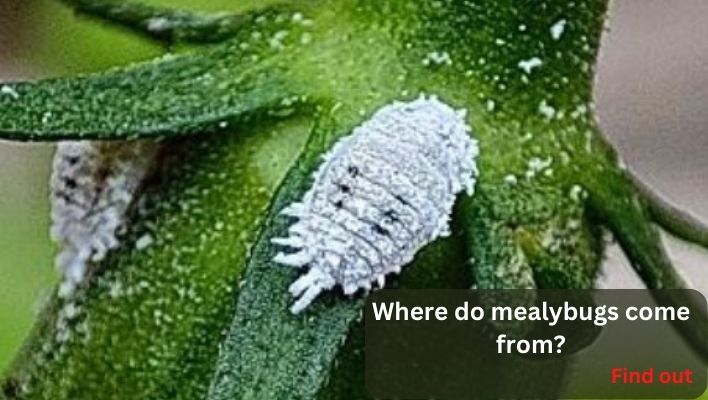Mealybugs are one of the most common indoor pests. They are known to spread rapidly indoors and can cause extensive damage to your home inside and out. Do you want to know where mealybugs come from?
Despite their small size, mealybugs can cause significant damage to plants through their feeding habits. They extract sap from the plants, weakening the plant and reducing its ability to produce flowers and fruit.
In addition, mealybugs secrete a sticky substance called honeydew, which can lead to the growth of sooty mold on the plants. This can further damage the plant and make it less attractive.
Overall, mealybugs are a common and persistent pest that can be difficult to control. Understanding where they come from and how they spread is important in preventing and managing infestations.
We’ll dive into the origins of mealybugs and how they’ve made their way into our homes and gardens. So if you’re ready to learn more about these pesky pests, keep reading.
What are Mealybugs
Mealybugs are small, soft-bodied insects that feed on the sap of plants. They are often found in clusters on the stems, leaves, and roots of plants, and they can cause significant damage if left unchecked. Mealybugs are usually about 1/4 inch long and have a waxy, white, or gray appearance.
They have piercing mouthparts that they use to feed on plant sap, and they can produce a sticky, honeydew-like substance as they feed. Mealybugs are common pests of many plants, including houseplants, fruit trees, and ornamental plants.

They can be difficult to control because they have a waxy coating that makes them resistant to many pesticides. If you have a mealybug infestation on your plants, it is important to take action to control the population and protect your plants from further damage.
Where do mealybugs come from
Mealybugs are a group of insects that come from the order Homoptera. They have much in common with aphids but are smaller and have a much softer exoskeleton.
Mealybugs are pests native to tropical and subtropical regions of the world, although they have been introduced to other parts of the world and have become established in some areas. They are common pests of a wide variety of plants, including many types of indoor and outdoor plants.
They feed on plant sap, damaging the plant and reducing its vigor. Mealybugs can be difficult to control once they become established, so it is important to take steps to prevent infestations.
Mealybugs can get to your plants in several ways. Some common ways include:
- Direct introduction: Mealybugs can crawl or fly onto your plants from other infested plants nearby.
- Transported by humans: Mealybugs can hitch a ride on your clothing or tools and then be transferred to your plants.
- Transported by insects or animals: Mealybugs can be carried on the bodies of insects or animals, such as ants or birds, and then be transferred to your plants.
- Transported through soil or water: Mealybugs can be transported through soil or water and then establish themselves on your plants.
- Purchasing infested plants: If you purchase plants already infested with mealybugs, they will be introduced to your garden or indoor plants.
They’re typically attracted to light or sugar but can also be found in areas with high humidity or moisture levels. And can be found on a variety of plants. They are usually white or yellow, and their bodies are covered in waxy hair. They cannot fly, but they have wings that help them move around the plant.
If you live in an area where mealybugs are common, you may notice them on your plants or trees yearly around this time of year.
Signs of mealybugs
Mealybugs are small, soft-bodied insects that can infest a variety of plants. They are often found in clusters underside of leaves, near leaf joints, or on the stem of a plant. Some signs of mealybug infestation include:

- White, cottony masses on the plant’s leaves, stems, or branches. These masses are often mistaken for mold or mildew, but upon closer inspection, you will see small, pale insects and their eggs hidden within.
- Stunted plant growth and yellowing or wilting leaves. Mealybugs can damage a plant by sucking the sap from its tissues, interfering with its ability to absorb water and nutrients.
- Honeydew. Mealybugs secrete a sticky, sweet substance called honeydew as they feed. This can coat the leaves and stems of the plant, attracting ants and promoting the growth of sooty mold.
- Distorted or curled leaves. Some plants may develop distorted or curled leaves due to mealybug feeding.
- If you see fuzzy “fuzz” on the tips of your leaves, that’s likely mealybugs sucking up all the moisture from your plant.
If you suspect your plant has mealybugs, it is important to act quickly to control the infestation. Mealybugs can reproduce rapidly and can be difficult to eradicate once they become established.
How do mealybugs spread from plant to plant
Mealybugs are common plant pests that can spread from plant to plant in several ways. One way is by crawling or flying short distances, where mealybugs crawl from one plant to another.
They can also be spread through contaminated tools or equipment, such as pruning shears, clothing, or gardening tools. Sometimes they can be transported through winds or insects.
In addition, mealybugs can be spread through the movement of infested plants or plant material, such as cuttings or pots with soil. Finally, mealybugs can be spread by certain insects, such as ants, which can transport the pests to other plants.
How fast do mealybugs spread
In ideal conditions, mealybugs can reproduce rapidly, with a single female producing hundreds of offspring in her lifetime. This can lead to rapid population growth and spread within a short period.
They can spread rapidly through a plant or garden if left unchecked, especially in warm and humid environments. They can crawl from plant to plant or be carried on clothing, tools, or other objects that come into contact with infested plants.
Generally, mealybugs reproduce quickly, with a female mealybug capable of laying over 600 eggs in her lifetime. In optimal conditions, mealybugs can multiply and spread within a few weeks or even days. However, their spread can be slowed or prevented by regularly inspecting and treating plants for mealybugs and taking measures to prevent their introduction to new areas.
Will mealy bugs ever go away?
It is unlikely that mealybugs will go away on their own. They are sucking insect that feeds on the sap of plants and can reproduce quickly. If left unchecked, they can severely damage or even kill the plant they are infesting.
It is important to take measures to control and eliminate mealybugs, such as using an insecticide or natural remedies such as neem oil or introducing predatory insects like ladybugs or green lacewings.
To effectively eliminate mealybugs infestation, it is necessary to implement a comprehensive pest control plan, which may include the use of chemical treatments, mechanical control methods, and cultural practices such as proper watering and sanitation.

How do I remove mealybugs from my plants?
There are several methods you can use to remove mealybugs from your plants:
- Physical removal: Using a cotton swab or a toothbrush, gently scrub the mealybugs and their egg masses off the plant. Be sure to dispose of them in a sealed container to prevent them from spreading.
- Insecticidal soap: Mix a small amount of insecticidal soap with water according to the manufacturer’s instructions and spray it onto the affected plants. This will kill the mealybugs on contact.
- Neem oil: Neem oil is a natural pesticide that can be used to control mealybugs. Mix a small amount of neem oil with water according to the manufacturer’s instructions and spray it onto the affected plants.
- Biological control: You can also use natural predators, such as ladybugs, lacewings, or predatory mites, to control mealybugs. These predators will feed on the mealybugs and help keep their population in check.
- Chemical control: If the above methods are not effective, you may need to use a chemical insecticide. Be sure to follow the instructions on the label carefully, as overuse of chemical pesticides can be harmful to your plants and the environment.
Here is a detailed explanation of how to get rid of mealybugs from your plants and make your garden pest free.
How to prevent mealybugs
To prevent mealybugs from infesting your plants, keep an eye out for their presence and take action as soon as you see them. There are several steps you can take to prevent mealybugs from infesting your plants:
- Keep your plants clean and healthy: Mealybugs are attracted to plants that are stressed or damaged. Keep your plants well-watered and fertilized to help them stay healthy and resistant to pests.
- Isolate new plants: When you bring new plants home, isolate them from your other plants for a few weeks. This will allow you to watch for any signs of mealybugs or other pests and treat them before they spread to your other plants.
- Check plants regularly: Regularly inspect your plants for mealybugs or other pests. If you notice any, remove them immediately.
- Use natural predators: Ladybugs, lacewings, and predatory mites are all-natural predators of mealybugs and can help keep their populations in check.
- Use physical barriers: If growing plants prone to mealybugs, consider using physical barriers such as netting or horticultural fleece to protect them.
- Use organic pest control methods: There are several organic pest control methods you can use to get rid of mealybugs, such as horticultural oil, neem oil, or soap and water.
- Avoid overwatering: Mealybugs thrive in moist environments, so be sure to water your plants only when they are dry to the touch. Overwatering can lead to the growth of mold, which can attract mealybugs.
- Prune-infected plants: If you notice that a plant is heavily infested with mealybugs, it may be necessary to prune off the infected parts to prevent the pests from spreading.
- Keep the area clean: Keep the area around your plants clean and free of debris, as this can provide a breeding ground for mealybugs.
- Use natural repellents: Certain plants, such as marigolds, can help deter mealybugs from infesting your plants. Planting these plants near your other plants may help prevent an infestation.
- Avoid over-crowding: Mealybugs often thrive in crowded areas where plants touch each other. To prevent this, ensure your plants have enough space to grow and avoid planting them too close together.
- Use traps: Yellow sticky traps can help attract and trap mealybugs, allowing you to remove them from your plants.
- Use a beneficial fungus: The beneficial fungus, Beauveria bassiana, can be used to kill mealybugs. It is a natural and organic way to control mealybug populations.
- Use proper hygiene: Avoid sharing tools or equipment with other gardeners, as this can spread mealybugs and other pests from one plant to another.
- Use proper plant care: Proper plant care, including proper watering, fertilizing, and pruning, can help prevent plants from becoming stressed and more susceptible to mealybug infestations.
Keep your plants well-watered and fertilized to promote healthy growth, which can help them resist infestation. Avoid overcrowding your plants, as this can create a favorable environment for mealybugs to thrive. Finally, clean up debris or fallen leaves around your plants to remove any potential hiding spots for mealybugs.
